Border Gate Economic Zone - The development of 30 years. What is the direction for the new period? The last Part: Vision and priorities
Summing up after nearly 30 years of operation, 26 economic zones across the country have played an important role in the socio-economic development of mountainous and border provinces, contributing to changing the face of an economic region as well as improving people's living standards. Up to now, a question has been raised as to which direction for the SEZs in the international and national context has changed.
 |
| Some SEZs "early start and stop" because they were formed in remote places, while the transport infrastructure is still poor. Photo taken at Moc Bai border gate duty-free shop area, July 19, 2022. Photo: Thu Diu |
Open to trade and strongly keeping the border
In 1996, Mong Cai - Quang Ninh Economic Zone was established with pilot policies applied for the first time. After that, a series of SEZs was born with the goal of "Opening up for trade", "Keeping the border firmly" with neighboring countries China, Cambodia, and Laos.
Mr. Le Thanh Quan, Director of the Department of Management of Economic Zones (Ministry of Planning and Investment), said that there are currently 26 economic zones in the country located in 21 of 25 land border provinces with a total area of about approx. 766,000 hectares, of which, there are nine economic zones bordering China, nine economic zones bordering Laos and nine economic zones bordering Cambodia (Bo Y international economic zone, Kon Tum province has just bordered Laos has just bordered Cambodia).
After nearly 30 years of operation, SEZs have clearly affirmed their important role in socio-economic development, ensuring security and defense in mountainous and border provinces. Specifically, the total export turnover through the SEZs reached US$13.5 billion, up 2.5 times compared to 2010 and nearly 8 times higher than 2005. The average growth rate of the period 2006-2010 reached 25%, in the period 2011-2015 reached 20%, in the period 2016-2020, the average growth rate reached nearly 19%/year, higher than the average growth rate of the whole country in the same period.
The number of people and means of entry and exit through the economic zones has increased steadily over the years. Total state budget revenue through the SEZs annually reaches over VND10,000 billion, mainly concentrated in the SEZs bordering China.
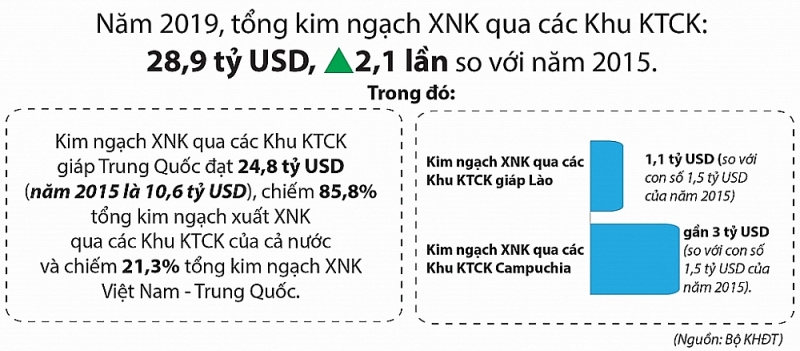 |
| Info: P.Anh |
Regarding investment attraction results, as of 2017, economic zones across the country have attracted about 800 investment projects, of which 700 are domestic investment projects with a registered capital of over VND50,000 billion and about 100 projects with foreign direct investment capital with a total registered capital of US$700 million.
The latest data from the report summarizing the implementation of the Project "Review and develop criteria for selecting a number of economic zones to focus on development investment from the state budget 2016-2020" and proposed selection of eight SEZs focusing on investment in the 2021-2025 period, of the Ministry of Planning and Investment (MPI), shows that by 2020, SEZs nationwide have attracted over 575 investment projects from investors in the country from domestic and foreign investment capital with a total investment capital of about VND83 trillion and over US$1 billion.
From the above specific figures, it can be seen that the established SEZs have promoted the advantages of border-gate economic-trade relations, attracting channels of goods, investment, trade, services and tourism from all over the country from abroad to inland through preferential policies and mechanisms in the economic zones. This has helped industries and localities across the country, depending on the size and attractiveness of the preferential policy mechanism, to shift the production and circulation of goods accordingly.
Investment incentives are effective
After many years of development, the reality shows that the current model of the SEZ is showing certain limitations.
According to Assoc. Dr. Nguyen The Chinh, former director of the Institute of Strategy and Policy on Natural Resources and Environment, Ministry of Natural Resources and Environment, many SEZs, due to their geographical location in the border area and geographical areas with socio-economic conditions, there are still many difficulties and conditions for development, so the demand for commodity trading is still limited.
Many believe that the current "spread" of investment in so many SEZs is becoming a burden on the budget.
Overall, this priority solution to "pour" capital of the Government has been diligently applied many years ago. In the 2016-2020 period, the Government has also selected nine key economic zones to focus on development investment from the state budget, including Mong Cai (Quang Ninh); Dong Dang (Lang Son); Lao Cai; As tall as; Cau Treo (Ha Tinh); Cha Lo (Quang Binh); Lao Bao (Quang Tri); Moc Bai (Tay Ninh); An Giang.
Previously, in the 2013-2015 period, eight SEZs were selected by the Government to focus on investment, including Mong Cai (Quang Ninh); Dong Dang (Lang Son); Lao Cai; Cau Treo (Ha Tinh); Lao Bao (Quang Tri); Bo Y (Kom Tum); Moc Bai, (Tay Ninh); An Giang.
In three consecutive phases, the list of "spikes" prioritized by the Government for investment has not changed much, but reality has shown that under this priority, the selected SEZs have not been promoted. With all the advantages, there has not really been a breakthrough in development.
According to the Ministry of Planning and Investment, the selection of eight of 26 SEZs to focus on investment is based on the results of the development of the economic zones in all aspects of socio-economic and national defense and security.
The review and selection proposal is based on two groups of criteria. The first group of criteria is quantitative, reflecting the level, development results and contribution of each economic zone through general economic indicators such as import-export turnover, budget revenue, and number of people entering and leaving.
The above indicators show the level, development results and contribution of the SEZ to the socio-economic development of each locality and of the whole country.
The second group of criteria which is qualitative is determined on the basis of assessing the strategic location of the economic zones on important corridors and economic belts in cooperation with bordering countries in ASEAN and the Greater Mekong Sub-region countries.
It can be said that the selection of priorities has been considered carefully on the basis of many criteria.
At the end of 2020, on the basis of the proposal of the Ministry of Planning and Investment, the Government has agreed to a list of eight concentrated economic zones with priority for investment in the 2021-2025 period. These are: Mong Cai (Quang Ninh), Dong Dang (Lang Son), Lao Cai, Cao Bang; Cau Treo (Ha Tinh), Lao Bao (Quang Tri); Moc Bai (Tay Ninh), An Giang.
The latest assessment of the Ministry of Planning and Investment shows that only two SEZs adjacent to China, Mong Cai and Dong Dang, have had development, the rest of the SEZs have not had a breakthrough, even regressed like Lao Bao, Cau Treo, Bo Y.
It can be understood that in addition to relying on the central budget, localities have made little effort.
For example, for infrastructure investment, after the policy of leaving 50% of revenue from the border gate to the locality changed, some SEZs were neglected and ignored by the local authorities. Policies to encourage investment in SEZs are also difficult because not all localities have proper incentives and effective ways.
Another reason that, according to experts, has made some economic zones "soon set up then close" is because of their formation in remote places while the transport infrastructure is still poor, not synchronized; access to land is still difficult and indirect factors from the border security situation.
Choice problem
The point of view of many experts is that investment should not and cannot be spread out, but must choose a spearhead to invest in developing the SEZ. However, the selection problem is not easy.
Bo Y-Kom Tum Economic Zone (in 2007) has a very special geographical position when there is an international border gate with Laos and a national border gate with Cambodia. This is a dynamic economic zone, the center of the development triangle of three countries Vietnam - Laos - Cambodia; is a highlight in the linkage strategy to create opportunities for cooperation and equal development between ASEAN countries and the Mekong sub-region. It is an important intersection connecting the provinces of the Central Highlands, Central Coast, and Southeast Vietnam with the provinces of Southern Laos, Northeast Thailand, Cambodia and Myanmar. However, after 15 years of operation, this place still cannot flourish with the weakest point, the most difficult to overcome is the infrastructure system which has not been invested synchronously, it is still a remote location, and goods are difficult to transport (no railway, seaport, far from the airport).
Therefore, although it is considered a golden location, this area is no longer a priority choice for development. The Ministry of Planning and Investment has taken into account the adjustment of the area of Bo Y SEZ from 70,000 ha to 16,000 ha (decreased by more than 4 times). The policy mechanism of this area is not particularly favorable (following the law on investment, law on enterprises, Decree No. 82/2018/ND-CP on management of industrial and economic zones; and other relevant legal documents).
If in the 2013-2015 period, Bo Y was one of the eight economic zones prioritized by the Government to invest in development investment, then in the 2016-2020 period, the name “Bo Y” was not prioritized by the Government. Even in the 2021-2025 period, Bo Y will not be selected.
From a local perspective, Moc Bai Economic Zone (Tay Ninh) is highly expected by Tay Ninh province, considered the direction of the economic breakthrough of the province.
There are three border gates (Moc Bai international border gate and Phuoc Chi border gate, Long Thuan), serving economic exchange activities between Vietnam and Cambodia and other ASEAN countries (from Myanmar, passing through Thailand, Cambodia, Laos, Vietnam and ending in Guangxi, China).
With this road, Moc Bai is only 70km from Ho Chi Minh City, the largest economic center of Vietnam and 170km from the capital Phnom Penh of Cambodia, becoming an important intersection between the international and national road system in the South of our country.
However, up to now, after 22 years of pilot application of a number of policies and 11 years of implementing the Prime Minister's decision to adjust the Master Plan on the construction of Moc Bai Economic Zone, attracting domestic and foreign investors is still limited and inadequate, most of which are domestic investment projects, with small scale, weak financial capacity.
According to the leader of Tay Ninh province, the main reason is that Moc Bai SEZ still lacks policies to attract investment for large-scale, high-tech industrial - urban - service development, which is not attractive to large businesses, making strategic investments, leading to not being able to create the main driving force for development. Investment capital from the central government and Tay Ninh province is insignificant and limited, so the infrastructure of Moc Bai SEZ has not been synchronously invested.
Therefore, despite determining development priorities and expecting to have a suitable development model, this makes it, even finding the right development model is still embarrassing for the province when the development goals and orientations of this economic zone are no longer appropriate.
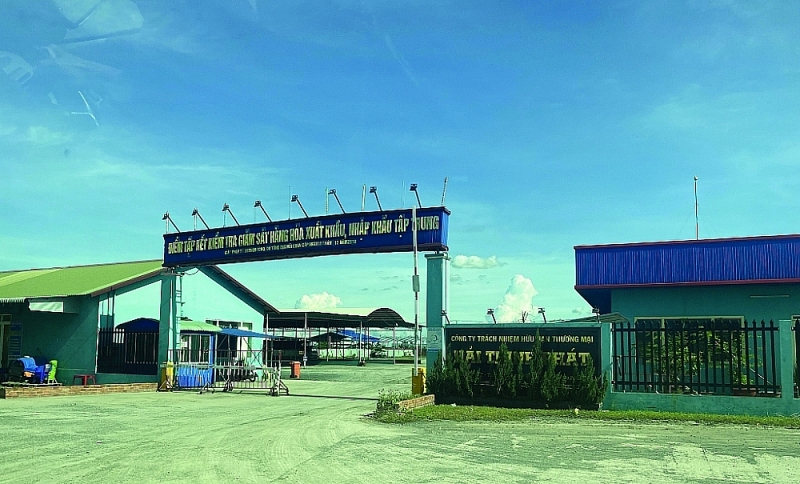 |
| Checkpoint for import and export goods at Khanh Binh border gate, An Giang. Photo: Thu Diu |
Long-term vision, specific solutions
In March 2022, the Government also issued Resolution 23/NQ-CP on the economic development of land border areas, clearly stating that: “The border area is an important area, playing the role of a nation, so economic development, trade and social security in this area is very necessary.”
In April 2022, the Ministry of Planning and Investment issued Document No. 2703/BKHDT-CLPT to the People's Committees of provinces and cities and requested a report on the development of the economic zone to serve as a basis for making the national master plan for the 2021-2030 period; at the same time, it also serves as a basis for proposing development orientations of priority and encouraging areas.
This shows that the Government is still determined to develop the economic zone in the coming period. And choosing the spearhead and focusing on investment is still an important solution given by economic experts as well as management agencies for the development of the SEZ model.
This orientation is also given by the Ministry of Planning and Investment with the view of developing SEZs in border areas into dynamic economic zones of each province bordering China, Laos and Cambodia; closely combining the development of securities markets with ensuring national defense and security in the land border areas, completing the infrastructure in the economic zones with full convergence of economic development strengths and high annual budget revenues and having a large import-export turnover in order to promote economic and trade development at the border gate area.
In the 2021-2025 period, investment and development will be focused on from the state budget to basically complete the important technical infrastructure works of the SEZ to meet the requirements of large-scale investment projects, forming freight transshipment centers.
However, in order for central budget capital to truly become bait, localities need to improve their role in guiding the support capital from the central budget according to the motto of taking public investment to lead investment, simplify administrative procedures, create a favorable and open business environment, and attract investors in accordance with the potential and strengths of the locality.
In fact, these solutions of the management agency are said to be nothing new compared to the past, there is no breakthrough solution. While in fact, localities have not had the initiative in selecting and determining development goals and directions.
Economic expert Dr. Nguyen Xuan Thuy also affirmed that countries around the world, especially developing countries, continue to consider SEZs as an effective model for industrial development and investment attraction. However, the traditional SEZ models based mainly on financial incentives are being strongly transformed into advanced management models; industrial cooperation and symbiosis for efficient use of raw materials, energy, resources, and shared services.
In addition, the fourth industrial revolution and the impacts of the Covid-19 pandemic have promoted the transformation of production models, business cooperation, and global value chains; methods of operating, organizing and mobilizing resources of enterprises, transforming enterprises from simple digitization to innovative forms based on a combination of various technologies. This has been setting requirements for new demand in the development of the economic zones of Vietnam in the future.
With the Government's goals and determination, it is expected to soon have a long-term overview with specific solutions for the development of the SEZ in the new context.
Related News
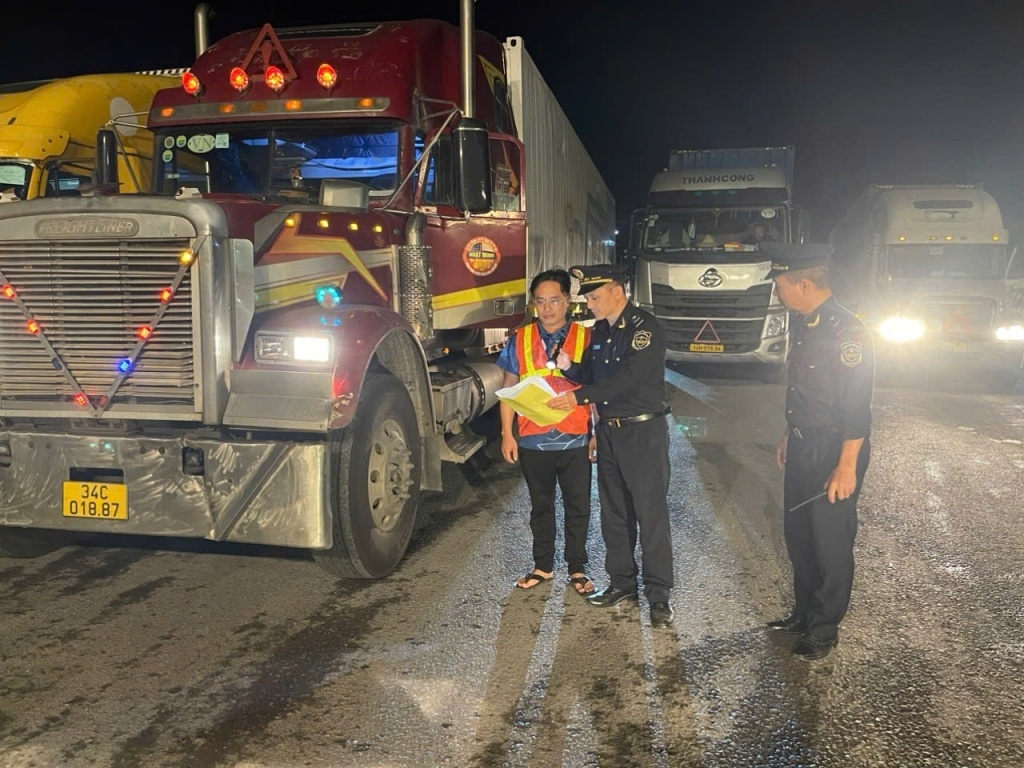
Mong Cai Border Gate Customs Branch makes great effort in performing work
11:23 | 16/12/2024 Customs
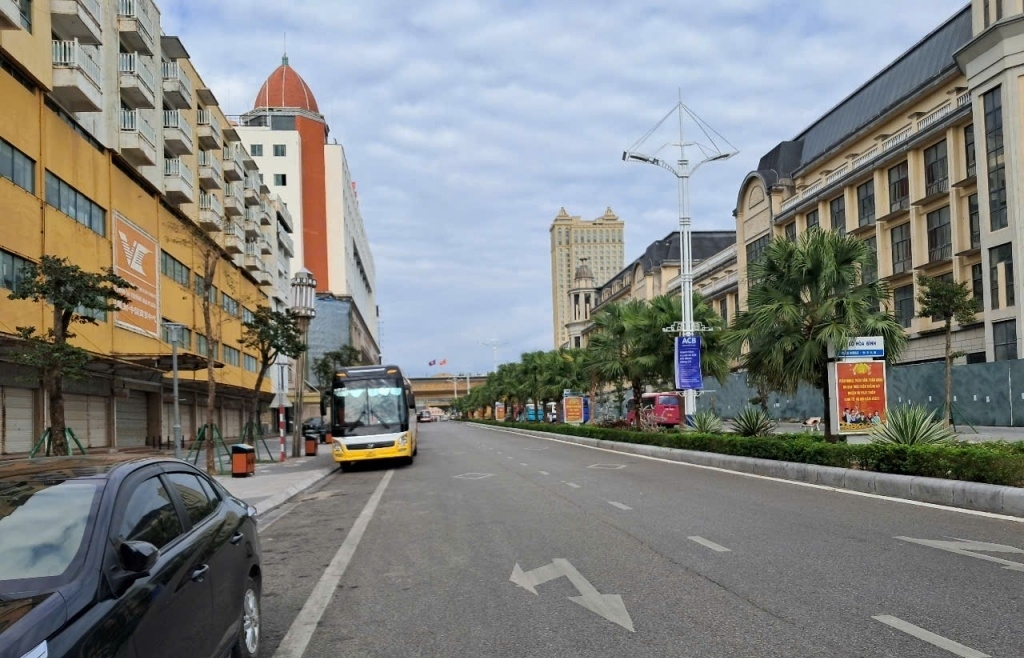
Mong Cai: Smuggling concerns amid sluggish business activities
09:43 | 08/12/2024 Anti-Smuggling
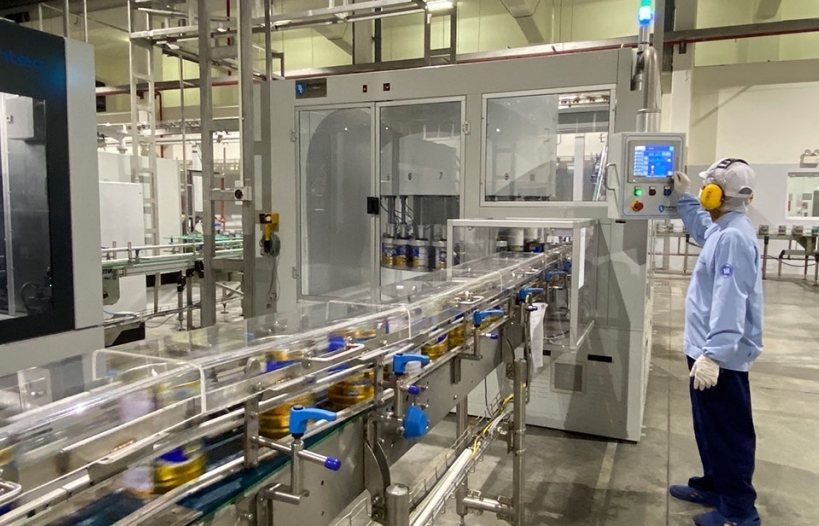
Green transformation: It's time to force businesses to "get involved"
09:23 | 25/11/2024 Headlines
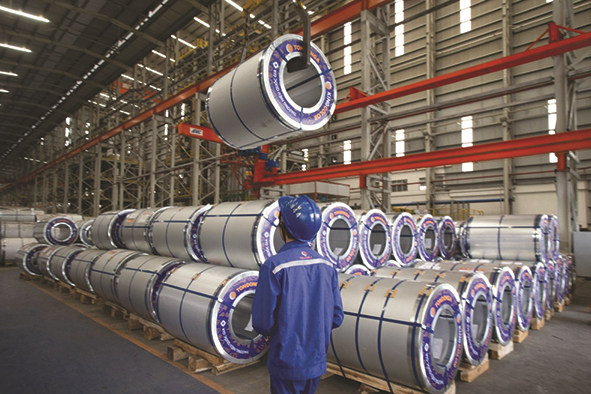
Accelerating investment to meet "green" standards
09:02 | 24/11/2024 Import-Export
Latest News

UK a niche market for Vietnamese speciality coffee
14:11 | 23/12/2024 Import-Export

Vietnam-US trade thrives on effective mechanisms: trade counsellor
14:08 | 23/12/2024 Import-Export

Opening of overseas markets boosts coconut exports
13:59 | 23/12/2024 Import-Export

Increasing consumption demand, steel enterprises face many opportunities
11:08 | 23/12/2024 Import-Export
More News

VN faced with increasing trade defence investigations on rising protectionism
18:58 | 22/12/2024 Import-Export

Việt Nam expects to officially export passion fruit to the US next year
18:55 | 22/12/2024 Import-Export

UK’s carbon tax to affect VN exports
18:51 | 22/12/2024 Import-Export

Removing obstacles in granting certificates of exploited aquatic products
13:56 | 22/12/2024 Import-Export

Promoting agricultural exports to the Japanese market
13:55 | 22/12/2024 Import-Export

Agricultural exports in 2024 to exceed 60 billion USD?
13:53 | 22/12/2024 Import-Export

Seafood exports expected to exceed $10 billion in 2025: expert
20:28 | 21/12/2024 Import-Export
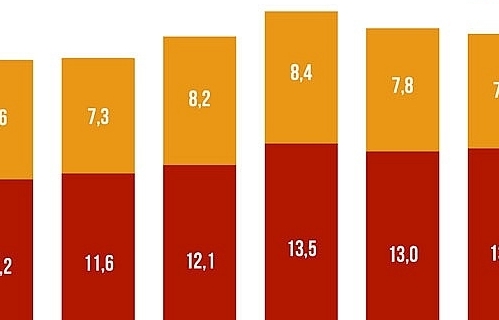
Top 10 Reputable Animal Feed Companies in 2024: Efforts to survive the challenges of nature
18:30 | 21/12/2024 Import-Export

Vietnam's import-export surges 15.3%
09:44 | 20/12/2024 Import-Export
Your care

UK a niche market for Vietnamese speciality coffee
14:11 | 23/12/2024 Import-Export

Vietnam-US trade thrives on effective mechanisms: trade counsellor
14:08 | 23/12/2024 Import-Export

Opening of overseas markets boosts coconut exports
13:59 | 23/12/2024 Import-Export

Increasing consumption demand, steel enterprises face many opportunities
11:08 | 23/12/2024 Import-Export

VN faced with increasing trade defence investigations on rising protectionism
18:58 | 22/12/2024 Import-Export




